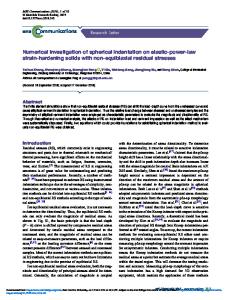Linear strain hardening in elastoplastic indentation contact
- PDF / 228,202 Bytes
- 10 Pages / 612 x 792 pts (letter) Page_size
- 108 Downloads / 415 Views
T. Akatsu and S. Numata Materials and Structures Laboratory, Tokyo Institute of Technology, 4259 Nagatsuta, Midori-ku, Yokohama 226-8503, Japan
K. Matsuda Department of Mechanical and Control Engineering, Kyushu Institute of Technology, 1-1 Sensui-cho, Tobata-ku, Kitakyushu 804-8550, Japan (Received 21 April 2003; accepted 6 June 2003)
Finite-element analyses for elastoplastic cone indentations were conducted in which the effect of linear strain hardening on indentation behavior was intensively examined in relation to the influences of the frictional coefficient () at the indenter/material contact interface and of the inclined face angle () of the cone indenter. A novel procedure of “graphical superposition” was proposed to determine the representative yield stress YR. It was confirmed that the concept of YR applied to elastic-perfectlyplastic solids is sufficient enough for describing the indentation behavior of strainhardening elastoplastic solids. The representative plastic strain of ⑀R (plastic) ≈ 0.22 tan , at which YR is prescribed, is applicable to the strain-hardening elastoplastic solids, affording a quantitative relationship of YR ⳱ Y + ⑀R (plastic) × Ep in terms of the strain-hardening modulus Ep. The true hardness H as a measure for plasticity is estimated from the Meyer hardness HM and then successfully related to the yield stress Y as H ⳱ C(,) × Y for elastic-perfectly-plastic solids and as H ⳱ C(,) × YR for strain-hardening solids, by the use of a - and -dependent constraint factor C(,) ranging from 2.6 to 3.2.
I. INTRODUCTION
A conical/pyramidal indenter produces elastic deformation as well as plastic flow for the smallest loads when it first touches the surface of elastoplastic materials if the tip of the indenter is geometrically perfect.1 Once penetration has commenced, the impression formed is geometrically similar in shape. Consequently, the mean pressure beneath the indenter in loading is independent of the size of impression. The Meyer hardness HM, as a mean pressure for conical/pyramidal indentation, has been defined by the ratio of peak load Pmax to the projected area Ar of residual impression (HM ⳱ Pmax/Ar), implying that it is also independent of Pmax and the penetration depth hmax at Pmax. The Meyer hardness HM is a measure for elastoplastic deformation/flow, depending
a)
Address all correspondence to this author. e-mail: [email protected] This author was an editor of this journal during the review and decision stage. For the JMR policy on review and publication of manuscripts authored by editors, please refer to http://www. mrs.org/publications/jmr/policy.html. J. Mater. Res., Vol. 18, No. 9, Sep 2003
http://journals.cambridge.org
Downloaded: 08 Jan 2015
on the elasticity (Young’ modulus E) and the plasticity (yield stress Y) of materials tested. Furthermore, HM is significantly dependent on the inclined face angle  of cone/pyramid to the material surface indented.2–6 For materials that undergo strain hardening (work hardening) as a result of the indentation pr
Data Loading...











